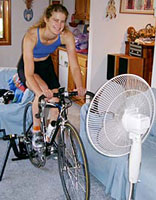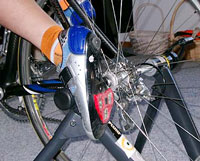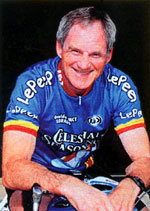Indoor Cycling, The Workouts
 By Fred Matheny
By Fred Matheny
Trainer workouts using segments
I use a segmented approach to indoor cycling workouts. Here's how it works: Each segment below is a self-contained workout spanning 15-20 minutes. Segments are designed to accomplish a specific training objective, such as warming up, improving speed or increasing power. Segments can be combined to fill the amount of time you want to spend on the workout. Segments can be chosen to pinpoint specific skills you want to improve.
Remember that these segments are samples; and I've provided a lot to choose from. Each workout suggests several variations, and variety is the key to enjoying (not just surviving) your time on the trainer. I have also included guidelines for those using perceived exertion ("hard," "easy," etc.) to gauge effort, and for those familiar with heart-rate exertion levels. Use the one you prefer. (It's a good idea to purchase a heart-rate monitor if you are training seriously.)
|
TIP! Gear suggestions are expressed as, for example 39x19. This means a 39-tooth chainring (a size found on many bikes) combined with a 19-tooth cog. |
Trainer workouts are limited only by your imagination. In fact, it's possible to train indoors 3 times per week for several months and never duplicate a workout. Make it your goal never to do the same one twice. Be creative!
|
The Workout Segment: Warm Up and Cool Down
|
| Warm up (15 minutes). Start in a low gear of about 39x19, depending on the resistance of your trainer. Spin easily at about 70 revolutions per minute. Monitor your rpm by counting every time your right foot comes around during 30 seconds and multiply by 2. Each minute, increase cadence by several rpm. After 5 minutes, increase the gear. At the end of 15 minutes, you should be sweating lightly and your heart rate should be about 80 percent of max. Finish the warm up with several 10-second sprints in a large gear. |
| Cool down (10 minutes). When the main workout is complete, decrease cadence and gearing on 1-minute intervals until you're spinning an easy gear at about 70 rpm. Then get off. |
|
The Workout Segment: Leg Speed (1) |
| Spin-ups (20 minutes) |
| In a low gear (39x19), spin at 70 rpm for 60 seconds. |
| Each minute, increase cadence by 5 rpm. You'll know when cadence gets too fast to sustain for 60 seconds because your butt will bounce on the saddle. |
| When you start bouncing, reduce cadence by 5 rpm every minute to the end of the 20-minute segment. |
|
The Workout Segment: Leg Speed (2) |
| Stand and sprint (20 minutes) |
| In a moderate gear (53x19), stand and sprint at about 100 rpm for 15 seconds. |
| Sit and spin the same gear gently for 45 seconds. |
| Repeat steps 1 & 2 four times. |
| In a fairly large gear (53x17), stand and sprint hard for 10 seconds. |
| Sit down, shift to a fairly low gear (39x17) and spin easily for 50 seconds. |
| Repeat steps 4 and 5 nine times. |
|
The Workout Segment: Leg Speed (3) |
| One-leg speed (20 minutes) Note: One-Leg Pedaling is explained below. |
| In a low gear (39x19), spin at 90 rpm for 15 seconds. Then pedal slowly for 45 seconds. |
| Repeat 4 more times, but increase your cadence during the first 15 seconds by 5 rpm each time. |
| Unclip your left foot. In a low gear (39x21), spin with your right leg for 60 seconds at about 100 rpm. |
| Do the same with the left leg. |
| Repeat steps 3 and 4 four times. |
| Using both feet, repeat steps 1 and 2. |
 One-leg-pedaling trainer workout
One-leg-pedaling trainer workout
One-leg pedaling is an extremely effective way to work on strength and add variety to your indoor training at the same time. When you pedal with both legs, the leg that pulls the foot through the bottom of the stroke, up the back and over the top gets lazy. That's because the other leg is pushing the pedal down, a much more powerful and natural action than pulling the pedal up.
Now think about it. If your leg doesn't help bring the pedal up and over the top, it's just dead weight. It increases the resistance your muscles must overcome to move your bike down the road. This is why learning to pedal a complete, 360-degree circle with each leg makes you a better rider. One-leg pedaling drills teach your muscles and nervous system.
|
The Workout Segment: One-leg training |
| Warm up on the trainer for 20 minutes by pedaling with both legs. |
| Unclip your left foot from the pedal. Hook it back over the trainer just to the left of where it connects to the rear hub (photo). Or, rest it on a chair or stool just outside the left pedal circle. |
| Pedal at about 90 rpm with your right leg. Use an easy gear until you get accustomed to the unusual feeling. You'll probably find it difficult to pedal for more than 2 or 3 minutes the first time. The muscles that lift your thigh and push the pedal over the top will fatigue quickly. But you'll improve rapidly. |
| After a few minutes of using the right leg, switch to the left and pedal for the same amount of time. |
| As you improve, increase the gear and the amount of time you pedal with each leg. |
|
TIP! To simulate riding uphill, put a block of wood under the front wheel to tilt the bike. A 4- or 5-inch block will do it. |
|
The Workout Segment: Climbing Power (1) |
| Minute on, minute off (20 minutes) |
| In the saddle using a fairly large gear (53x17), pedal at 90 rpm for 60 seconds. This should raise your heart rate to within 5 bpm of your lactate threshold (LT). It should feel "hard." |
| Shift to the small chainring and spin easily for 60 seconds. |
| Repeat 9 times. During the final 3 efforts, your heart rate will climb to your LT or slightly above as you near the end of 60 seconds. |
|
The Workout Segment: Climbing Power (2) |
| Stand and ascend (20 minutes) |
| In a big gear (53x13), stand and pedal rhythmically for 2 minutes. Your heart rate should rise to about 5 bmp below your lactate threshold. It should feel "hard." |
| Sit down, shift to the small chainring and spin easily for 2 minutes. |
| Repeat 4 times. During the final 3 efforts, your heart rate will climb to your LT or slightly above as you near the end of the 2 minutes. |
|
The Workout Segment: Climbing Power (3) |
| Up and down (20 minutes) |
| In a moderate gear (53x19), pedal for 5 minutes at a cadence around 90 rpm. |
| Stand and shift to a cog that's 2 or 3 teeth smaller than you were in while sitting. For example, if you pedal seated in 53x19, shift to the 17 or even the 15 when you stand. Intensity should feel "hard." Your heart rate should rise to your LT in the last 2 minutes. |
| Sit down, shift to the small chainring and spin easily for 5 minutes to recover. |
| Repeat once. |
Indoor riding & weights
You don't need to stay on the trainer for an entire workout. For example, you can alternate 2- or 3-minute cycling intervals at about 85 percent of your max heart rate with leg presses, squats or step-ups. The weight workout improves strength. The pedaling intervals remind your legs and nervous system that you're a cyclist, too. This workout is a great way to create strength and begin the process of converting it to cycling-specific power.
|
The Workout Segment: Time Trial Power (1) |
| TT "threes" (20 minutes) |
| Ride for 3 minutes at a steady pace. Choose a gear that allows a cadence of 90-100 rpm but does not drive your heart rate past LT. It should feel "hard" but not exhausting. |
| Shift to the small chainring and pedal easily for 2 minutes. |
| Repeat 3 times. |
|
The Workout Segment: Time Trial Power (2) |
| TT ladder (20 minutes) |
| Choose a gear that lets you maintain a cadence of 90-100 rpm and a heart rate not exceeding your LT. It should feel "hard," but not exhausting. |
| Do a ladder like this: 1 minute hard, 1 minute easy 2 minutes hard, 2 minutes easy 3 minutes hard, 3 minutes easy 4 minutes hard, 4 minutes easy |
|
The Workout Segment: Time Trial Power (3) |
| TT "eights" (20 minutes) |
| Choose a gear that lets you maintain a cadence of 90-100 rpm and a heart rate not exceeding your LT. It should feel "hard, but not exhausting. |
| Ride at time trial cadence and intensity for 8 minutes. Check your cyclecomputer to see how far you go. Check your heart monitor to determine average heart rate. |
| Ride easily for 4 minutes. |
| Repeat the 8-minute TT and re-check distance and average heart rate. If you cover substantially less distance the second time, or your heart rate is more than 5 beats higher, it says you did the first effort too hard. |
|
The Workout Segment: Intervals (1) |
| Interval ladder (20 minutes) |
| Choose a gear that allows a cadence of 90-100 rpm for the length of each interval. Intensity should be "very hard" at the end of each work period. |
|
Do a ladder like this: |
|
The Workout Segment: Intervals (2) |
| Interval "threes" (18 minutes) |
| Choose a gear that allows a cadence of 90-100 rpm for the length of each interval. Intensity should be "very hard" at the end of each work period. |
| Ride hard for 3 minutes. |
| Shift to the small chainring and pedal easily for 3 minutes. |
| Repeat 2 times. |
|
TIP! This article is devoted to making the most of indoor cycling, but you should know that experienced riders usually don't get on their trainer frequently in the winter. They know that stationary cycling can be mentally taxing. If they use up their store of enthusiasm in January, they'll hate getting on the trainer in spring when bad weather interferes with riding the road. Instead, they crosstrain in winter and save the trainer for spring. Then when they need a hard workout but can't get outside, they don't mind climbing on their nowhere bike. |
 This Signature Series article is provided courtesy of RoadBikeRider.com. It comes from RoadBikeRider's bible of training for cycling, Fred Matheny's Complete Book of Road Bike Training by Fred Matheny.
This Signature Series article is provided courtesy of RoadBikeRider.com. It comes from RoadBikeRider's bible of training for cycling, Fred Matheny's Complete Book of Road Bike Training by Fred Matheny.
From the cover: During three decades as a road rider and cycling writer, Fred Matheny has built an international reputation for his contributions to the sport. In this, his thirteenth book, he amasses his knowledge and that of many other experts in what is truly the complete book of road bike training.
RoadBikeRider offers Fred's book, many more cycling guides and even a free weekly e-mail newsletter full of tips and news for aspiring bicyclists.
